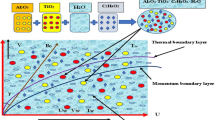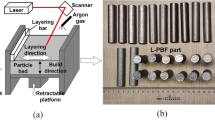Abstract
In this study, we propose a novel pressure threshold method for the Bingham numerical model and apply the method to simulate cement paste slump flow. Calculation is divided into three steps. First, the cement paste is computed as a Newtonian fluid. An advection step and a non-advection step are computed in sequence. In the non-advection step, the fractional steps are implemented to calculate viscous, gravity, and pressure terms. Second, a pressure threshold judgment is used to modify the motion state of cement paste cells. Third, an iterative correction, which is an iterative process to determine the precise unyielded (rigid) and yielded (fluid) regions, is conducted for the Bingham computational model. The volume/surface integrated average-based multi-moment method scheme is used to compose a new finite volume formula for solving general fluid dynamic problems. The tangent of hyperbola for interface capturing approach is used to capture free boundaries in multi-fluid simulations. The computational modeling enables accurate simulation of the flow process of cement paste to analyze different mix designs and to evaluate the workability of cement paste. The proposed methodology is relevant to computational mechanics with applications in cement flow simulations.
















Similar content being viewed by others
References
Okamura H, Ouchi M (2003) Self-compacting concrete. J Adv Concr Technol 1(1):5–15
Ferraris C F, Brower L, Ozyildirim C and Daczko J (2000) Workability of self-compacting concrete. In: Proceedings of the PCI/FHWA/FIB international symposium on high performance concrete, Orlando, September 2000, USA, pp 25–27
Roussel N, Geiker MR, Dufour F, Thrane LN, Szabo P (2007) Computational modeling of concrete flow: general overview. Cem Concr Res 37(9):1298–1307
Roussel N (2005) Steady and transient flow behaviour of fresh cement pastes. Cem Concr Res 35(9):1656–1664
Roussel N, Coussot P (2005) “Fifty-cent rheometer” for yield stress measurements: from slump to spreading flow. J Rheol 49(3):705–718
Mechtcherine V, Gram A, Krenzer K, Schwabe J H, Shyshko S, Roussel N (2014) Simulation of fresh concrete flow using Discrete Element Method (DEM): theory and applications. Mater Struct 47:615–630
Gram A, Silfwerbrand J (2011) Numerical simulation of fresh SCC flow: applications. Mater Struct 44(4):805–813
Zheng J, An X, Huang M (2012) GPU-based parallel algorithm for particle contact detection and its application in self-compacting concrete flow simulations. Comput Struct 112–113:193–204
Frigaard IA, Nouar C (2005) On the usage of viscosity regularisation methods for visco-plastic fluid flow computation. J Nonnewton Fluid Mech 127(1):1–26
Bouvet A, Ghorbel E, Bennacer R (2010) The mini-conical slump flow test: analysis and numerical study. Cem Concr Res 40(10):1517–1523
Sulsky D, Schreyer H (1996) Antisymmetric form of the material point method with applications to upsetting and Taylor impact problem. Comp Methods Appl Mech Eng 139:409–429
Moresi L, Dufour F, Mühlhaus HB (2003) A Lagrangian integration point finite element method for large deformation modeling of viscoelastic geomaterials. J Compar Phys 184:476–497
Kulasegaram S, Karihaloo BL, Ghanbari A (2011) Modelling the flow of self-compacting concrete. Int J Numer Anal Methods Geomech 35(6):713–723
Lashkarbolouk H, Halabian A, Chamani M (2013) Simulation of concrete flow in V-funnel test and the proper range of viscosity and yield stress for SCC. Mater Struct. doi:10.1617/s11527-013-0147-9
Mitsoulis E (2007) Flows of viscoplastic materials: models and computations. Rheol Rev 135–178
Dean EJ, Glowinski R, Guidoboni G (2007) On the numerical simulation of Bingham visco-plastic flow: old and new results. J Nonnewton Fluid Mech 142(1–3):36–62
Tanner R, Milthorpe J (1983) Numerical simulation of the flow of fluids with yield stress. Numer Methods Lami Turb Flow, Seattle, pp 680–690
Papanastasiou TC (1987) Flows of materials with yield. J Rheol 31(5):385–404
Glowinski R (1984) Numerical methods for nonlinear variational problems. Springer, New York
Sánchez FJ (1998) Application of a first-order operator splitting method to Bingham fluid flow simulation. Comput Math Appl 36(3):71–86
Huilgol R (2002) Variational inequalities in the flows of yield stress fluids including inertia: theory and applications. Phys Fluids 14:1269
Olshanskii MA (2009) Analysis of semi-staggered finite-difference method with application to Bingham flows. Comput Methods Appl Mech Eng 198(9–12):975–985
Syrakos A, Georgiou GC, Alexandrou AN (2013) Solution of the square lid-driven cavity flow of a Bingham plastic using the finite volume method. J Nonnewton Fluid Mech 195:19–31
Yabe T, Aoki T (1991) A universal solver for hyperbolic equations by cubic-polynomial interpolation I. One-dimensional solver. Comput Phys Commun 66(2–3):219–232
Takewaki H, Nishiguchi A, Yabe T (1985) Cubic interpolated pseudoparticle method (CIP) for solving hyperbolic type equations. J Comput Phys 61:261–268
Yabe T, Tanaka R, Nakamura T, Xiao F (2001) An exactly conservative semi-lagrangian scheme (CIP–CSL) in one dimension. Mon Weather Rev 129(2):332–344
Xiao F, Akoh R, Ii S (2006) Unified formulation for compressible and incompressible flows by using multi-integrated moments II: multi-dimensional version for compressible and incompressible flows. J Comput Phys 213(1):31–56
Xiao F (2004) Unified formulation for compressible and incompressible flows by using multi-integrated moments I: one-dimensional inviscid compressible flow. J Comput Phys 195(2):629–654
Xiao F, Honma Y, Kono T (2005) A simple algebraic interface capturing scheme using hyperbolic tangent function. Int J Numer Methods Fluids 48(9):1023–1040
Xiao F, Ebisuzaki T (1999) A computational model for incompressible flow including surface tension. Commun Numer Methods Eng 15:887–895
Moriguchi S, Borja RI, Yashima A, Sawada K (2009) Estimating the impact force generated by granular flow on a rigid obstruction. Acta Geotech 4(1):57–71
Hirt CW, Nichols BD (1981) Volume of fluid (VOF) method for the dynamics of free boundaries. J Comput Phys 39(1):201–225
Tryggvason G, Bunner B, Esmaeeli A, Juric D, Al-Rawahi N, Tauber W, Han J, Nas S, Jan YJ (2001) A front-tracking method for the computations of multiphase flow. J Comput Phys 169(2):708–759
der Vorst Van (1992) Bi-CGSTAB: a fast and smoothly converging variant of Bi-CG for the solution of nonsymmetric linear systems. SIAM J Sci Stat Comput 13(2):631–644
Clappier A (1998) A correction method for use in multidimensional time-splitting advection algorithms: application to two and three dimensional transport. Mon Wea Rev 126:232–242
Acknowledgments
This work was supported by the State Key Laboratory of Hydro Science and Engineering (Grant No. 2012-Ky-02) and by the State Key Program of the National Natural Science of China (Grant No. 51239006) and by the National High-tech Research and Development Program of China (Grant No.2012AA06A112). Thanks for the reviewers’ prospective comments and suggestions which improve the paper a lot.
Author information
Authors and Affiliations
Corresponding author
Rights and permissions
About this article
Cite this article
Zheng, J., An, X. & Wu, Q. Numerical pressure threshold method to simulate cement paste slump flow. Mater Struct 48, 2063–2081 (2015). https://doi.org/10.1617/s11527-014-0293-8
Received:
Accepted:
Published:
Issue Date:
DOI: https://doi.org/10.1617/s11527-014-0293-8




